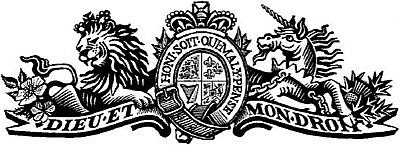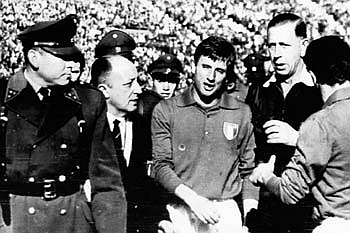| In the loving Memory & Spirit of the Game |
| Enjoy, your journey here on... KenAston.org |
|
|

 The Times - LONDON THURSDAY OCTOBER 25 2001 Obituary Ken Aston MBE Referee of the infamous Battle of Santiago in the 1962 World Cup Finals who went on to dream up red and yellow cards.  Ken Aston (second from right) helps to escort Ferrini from the field after a fight broke out when Italy played Chile in 1962 |
|
Introducing highlights of the World Cup game of 1962 between Chile and
Italy on BBC1, David Coleman said: “Good evening. The game you are about
to see is the most stupid, appalling, disgusting and disgraceful
exhibition of football possibly in the history of the game.” The referee
of the match, known as the “Battle of Santiago”, was Ken Aston. He went on to become chairman of the FIFA referees’ committee and introduced red and yellow cards to the game. But discipline was not his only priority. “The game should be a two-act play with 22 players on stage and the referee as the director,” he once said. “There is no script, no plot, you don’t know the ending, but the idea is to provide enjoyment.” Kenneth George Aston was born in Colchester and educated at Ilford County High School and St Luke’s College, Exeter, where he studied French and religious instruction. Immediately after leaving he qualified as a teacher and joined Newbury Park County Primary School in Essex, where he remained for the rest of his career, apart from his war service and a year at another school as deputy headmaster in 1949. Having been turned down for the RAF because of an injured ankle, he eventually served in the Royal Artillery. He was promoted rapidly, and in 1944 was seconded to the Indian Army. He was among the first Allied troops into Singapore, where he served on the Changi War Trials Commission, after the Japanese capitulation, and he returned home as a lieutenant-colonel. Aston had been asked to take charge of a football match at his school in 1935, and he qualified as a referee in the following year. He began in local leagues and progressed to the Football Combination, where he remained until he joined the list of league linesmen in the 1949-50 season. He was used to refereeing relatively calm games in England until the 1962 World Cup in Chile. The trouble there began when the local media claimed that Italian journalists had written articles which questioned the beauty and morals of Chilean women. Aston, who had taken charge of the opening game, was regarded as having a safe pair of hands, and as a result was asked to replace the designated official for Chile’s game against Italy. “I was less than happy,” he said later. “I asked for my own linesmen, but I had to stick with a Mexican and a little American from New York. They weren’t very good, so it became almost me against the 22 players.” Before the match began, a gift of carnations from the Italian players was rejected by the Chileans. After 12 seconds, the first player was booked. After 12 minutes, Giorgio Ferrini of Italy was sent off for a cynical foul. Then the Chilean left back Leonel Sanchez broke the nose of the Italian captain, Huberto Maschio, with a left hook. “I had my back to the incident at the time,” said Aston. “I’m sure the linesman saw it, but he refused to tell me.” When Mario David later aimed a kung-fu kick at Sanchez, he was also sent off. Armed police came on to the field three times to help Aston, who did not add on any stoppage time. Chile won 2-0. “I wasn’t reffing a football match,” he later recalled. “I was acting as an umpire in military manoeuvres.” Although he later advised referees never to lay a hand on a player, he admitted that on this occasion he had been “manhandling players left, right and centre”. Aston never refereed another World Cup match, but in 1964 he became chairman of the Fifa referees’ committee, a position which he held until Sir Stanley Rous was succeeded as President of Fifa by João Havelange. Aston remained Fifa’s chief refereeing instructor. He retired from domestic football in 1963 after taking charge of the FA Cup Final. But at the 1966 World Cup, in his role for Fifa, he became embroiled in another of the most controversial incidents of the history of the tournament, when England played Argentina in the quarter-final at Wembley. For an hour of a rough game England were unable to penetrate the Argentine defence. Then, with the Argentine players surrounding the German referee, Rudolf Kreitlein, to dispute another decision, their captain, Antonio Rattín, was sent off. For several minutes Rattín refused to leave the pitch, and then, when he did withdraw, he continued the argument in front of the royal box. “The gesturing went on for three minutes or so, and it became plain to me that, if no solution could be found soon, the match would have to be abandoned,” said Aston, who had overall responsibility for refereeing at the tournament. “I decided to go on and see what I could do.” He managed to persuade Rattín that to persist would not be good for the Argentine football authorities. England won 1-0. The match became significant for a further reason. Newspapers had reported that both Jack and Bobby Charlton had been booked, but there was no public indication of this from the referee, and the England manager Alf Ramsey had asked Fifa for clarification. Aston pondered how to make the position clearer. “As I drove down Kensington High Street, the traffic light turned red. I thought, ‘Yellow, take it easy; red, stop, you’re off’.” Red and yellow cards were introduced to the game at the World Cup finals in 1970. Aston’s confident opinions made him a respected authority on the laws of the game. As a result, he represented the footballers John O’Neill and Paul Elliott at the High Court, after their respective careers were ended by heavy challenges. Aston described one of the damaging tackles, by John Fashanu, as “the clearest case I have ever seen of a player jumping at an opponent”. “I know I’m a bloody old fool,” he once said, “but I think about the game.” He started up refereeing courses in America, and was able to say: “I have — and I know I have — made an enormous difference to the game in the USA.” A tournament in California was named after him — in which the winners were the best-performing referees and linesmen. In 1997 Aston was appointed MBE for “services to US soccer”. He was also the author of what he called the “Tehran Memo”, a ruling on the tackle from behind, which was subsequently outlawed by Fifa, to Aston’s disgust. “If it’s serious foul play, the player can be sent off, but not every time,” he said. “In my day, you were allowed to use your discretion. That’s the same whether it’s Wembley or Hackney Marshes.” Ken Aston is survived by his wife, Hilda, and by their son, Peter. Ken Aston, MBE, football referee, was born on September 1, 1915. He died on October 23, 2001, aged 86. |
|
If any one has any other... Pictures, Articles, Video, or
Comments of... Mr. Ken Aston MBE We would be happy & honored to include them on this Website. To submit use this link... ++ Tribute Submission ++ |